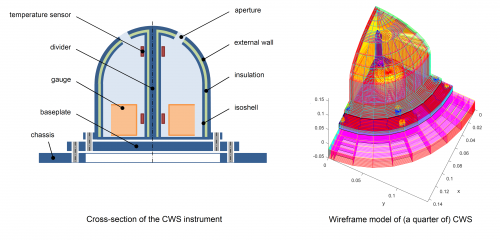The Daedalus mission
The Daedalus mission is a candidate for the Earth Explorer 10 slot in ESA’s Earth Observation program. It intends to study the Earth’s atmosphere in the region between 100 and 200 km altitude, the so-called “ignorosphere”, since it is too high to study with balloons and too low to keep a spacecraft at that altitude because of atmospheric friction.
The solution it adopts is to choose an elliptical orbit well into space, and to dip down into the atmosphere on each of its perigee passes. During such passes the atmospheric friction increases and peaks around the perigee at 115 km altitude. Below that altitude the atmospheric density rises very rapidly and so do the drag forces on the satellite.
The neutral cross-track wind sensor (CWS)
The cross-wind sensor is designed to measure the wind speed components in the plane perpendicular to the spacecraft velocity. Together with the ram speed sensor, a separate instrument, this enables to obtain the vertical and two horizontal wind speed components, after correcting for the spacecraft’s own velocity. The upper atmosphere winds can be up to a few km/s.
The operating principle is based on the pressure difference between two orthogonal pairs of gas collection volumes. The pressure in each volume is measured by means of a hot filament ionization gauge, which is a standard type of pressure sensor used in industrial applications and in space. During a Phase 0 study, we have developed an initial instrument design and we gained expertise with handling the ionization gauge.
The thermal problem
CWS (the neutral cross-track wind sensor) has to “feel” the wind as it moves at a speed of around 7 km/s through the upper atmosphere at perigee. Because the atmospheric density is not negligible at 115 km altitude, such a high relative velocity between spacecraft and the surrounding air leads to strong friction. Part of the energy inherent in the satellite motion is converted to heat, especially at the front side of the spacecraft, where CWS will be accommodated.
A thermal model was built to evaluate the effect of the frictional heat loads on the instrument. This model helped to determine the correct wall material and thickness, needed to conduct this heat to the instrument baseplate and the spacecraft chassis. An important issue is that the inner wall of the collection volumes has to be at constant temperature for a correct interpretation of the measurements. The collection volumes will therefore have a double wall with a layer of insulation in between.
Perspectives
In fall 2020 Daedalus passed a major review. Further work is now needed to arrive at a functional instrument prototype.
Want to know more?
European Space Agency. (2020). Report for Assessment: Earth Explorer 10 Candidate Mission Daedalus. European Space Agency, Noordwijk, The Netherlands, ESA-EOPSM-DAED-RP-3793.

